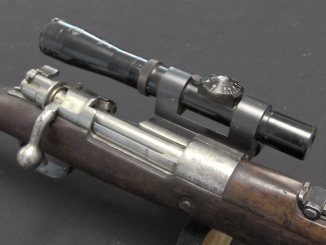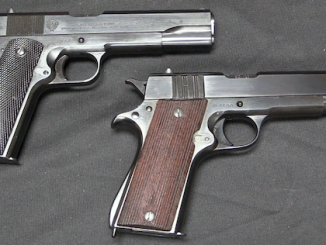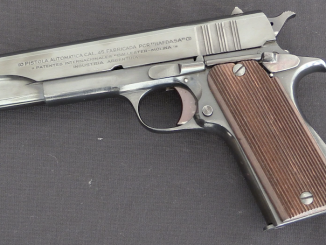Peru’s first standardized repeating rifle was the Model 1891 Mauser, as purchased in 1901 through Argentina. About 30,000 of these rifles were obtained when Argentina was unable to pay for them – although this may have been a quasi-diplomatic effort to hide Argentina’s interest in helping rearm Peru in light of their mutual hostility towards Chile). The rifles were standard 1891 pattern Mausers, with 5-round inline magazines, chambered for the early round-nose version of the 7.65x53mm Argentine Mauser cartridge.
Between 1910 and 1914, Peru was able to update its arsenal with about 50,000 new Models 1909 Mausers purchased from Germany – these being basically export versions of the German World War One Gewehr 98. The Peruvian rifles were still chambered for the 7.65mm cartridge, but now the new spitzer version, which offered much better ballistic performance.
Later, in the 1930s, the Peruvian military would go back and retrofit its old 1891 pattern rifles with new langevizier rear sights to use with spitzer ammunition, and put the rifles into reserve storage. There they would stay until sold as surplus, many of them arriving in the United States through Sam Cumming’s Interarms company.




I would have question (in broader sense, since this is a matter of metallurgy): with receiver left in ‘white’, what was proportion of constituent elements used or what kind was the ‘protective finish’?
According to common source, for steel to be stainless it has to contain at least 10.55 of Chromium. Common Cr contents in alloy gun quality steel is 5-7%. Both rifles and specifically the newer one are in gorgeous condition.
It could be an artifact of the heat treating process. Iron Chromium alloys exposed to heat and oxygen preferentially form an oxide rich in chromium. Initially the oxide forms at roughly the same proportions as the base metal, but oxygen binds better to the chromium than the iron. Once complete coverage is reached, further corrosion happens by metal diffusing outwards and oxygen diffusing inwards. Chromium is able to diffuse through the oxide better than iron. Also chromium oxide is more resistant to oxygen diffusion than iron oxide, which slows additional corrosion.
Of course it is much more complicated than this, but the heat treated bolt and receiver are more corrosion resistant after heat treating.
It was meant to be “at least 10.5% of Chromium….”
Widely used 316 steel has Chromium contents bit higher.
http://www.aksteel.com/pdf/markets_products/stainless/austenitic/316_316L_Data_Sheet.pdf
The 3 series stainless steels are austenitic
The typical member, 316, has 18% chromium 8% nickel.
The additional chromium is to achieve stainless in the presence of the nickel which is used to achieve the stability of the austenitic phase at room
The martensitic and ferritic stainless steels (4 series and ?series) typically have far lower chromium contents.
Room temperature
I just bought an 1891 Peruvian since first seeing this video. It’s in fair condition, very good bore, and has a matching bolt.
Interesting story, and good research, as always, Really appreciate your videos. Just a couple of comments about the M1891 Peruvian. You say that the Argentinian rifles bought by Peru where shipped back from Argentina to Germany, the crest ground off and a new one applied, and they where then shipped to Peru. On my peruvian M1891 (S2204) the crest was obviously applied to a new receiver, not to a ground down one. It seems to me that it was delivered directly from the factory like that. Also the few I have seen have no indication of the receiver been ground down and a new crest re-applied.
You say also that the receiver should have been ‘in the white’. That is surely correct for the M1909, but probably not correct for the M1891, according to literature and my own findings. The M1891 was most likely blued from the factory. The buttplates were white though.
Also the barrels on (many of) the Peruvian models where changed during the 1920s, and the Lange sight installed. However it seems also that the stocks were exchanged at the same time, since none Peruvian models I have seen has a serial number on the stock, something the Argentinian models had.